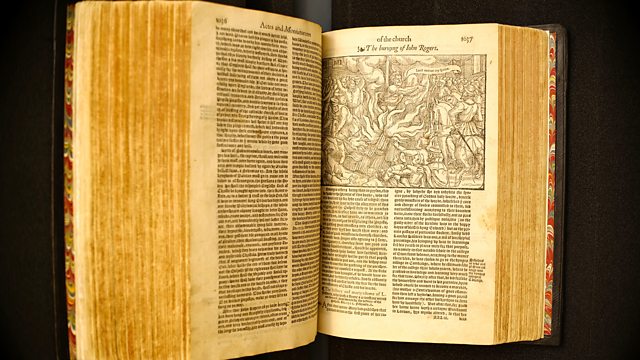Art That Made Us episode 3: In the 16th century, the British Isles experienced a religious revolution, as the kingdoms of England and then Scotland turned Protestant. Artists and experts today reveal how, during the reign of Elizabeth I, Protestants and Catholics used art, language and new technology to wage a battle for power in the Isles, creating surprising and often radical works.
Author Stephanie Merritt reassesses John Foxe’s grisly Book of Martyrs as a work of history and nationalist propaganda, with passages performed by actress Morfydd Clark, and we meet the indefatigable William Morgan, who undertook the ten-year task of translating and publishing the Bible in Welsh in 1588.
We discover how England’s emblem was the queen herself, with textiles artist James Merry exploring the mysterious Bacton Altar Cloth, now believed to be a fragment of one of Elizabeth’s power dresses seen in one of her many portraits. Elizabeth’s court swirls with religious intrigue, and the Ora Singers perform the daring, subversive Mass for Four Voices, a Catholic work created by William Byrd, a composer of the Royal Chapel and favourite of Elizabeth.
The queen also had a dangerous rival in Mary Queen of Scots. Jewellery designer Shaun Leane examines how Mary promoted her brand through jewels and fine Scottish gold work, while artist Alice Kettle assesses Mary’s embroideries and the coded messages in them that would contribute to her downfall. As Elizabeth expands exploration and empire in the 1590s, theatre, an explosive entertainment for the people, fed off the stories of distant lands coming back to the Isles. Artist Phoebe Boswell analyses Shakespeare’s attitude to race in his play Othello, supported by performances from actor Martins Imhangbe.
Art That Made Us episode 3
Bacton Altar Cloth
The Bacton Altar Cloth is a 16th-century garment that is considered the sole surviving dress of Queen Elizabeth I. The cloth, embroidered in an elaborate floral design and made of cloth of silver, is an important relic of Tudor fashion and luxury trade, containing dyes from as far away as India and Mexico. It was rediscovered in 2015 at St Faith’s Church in Bacton, Herefordshire, where it had been used as an altar cloth for centuries. After several years of conservation and restoration, the garment was exhibited to the public in 2019 and 2020 along with the Rainbow Portrait, in which the queen is depicted wearing a highly similar dress.
Foxe’s Book of Martyrs
The Actes and Monuments, popularly known as Foxe’s Book of Martyrs, is a work of Protestant history and martyrology by Protestant English historian John Foxe, first published in 1563 by John Day. It includes a polemical account of the sufferings of Protestants under the Catholic Church, with particular emphasis on England and Scotland. The book was highly influential in those countries and helped shape lasting popular notions of Catholicism there. The book went through four editions in Foxe’s lifetime and a number of later editions and abridgements, including some that specifically reduced the text to a Book of Martyrs.




